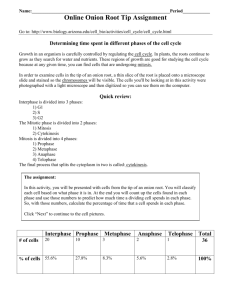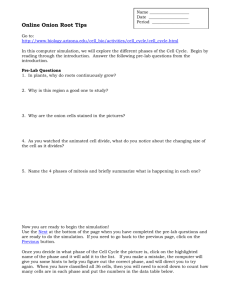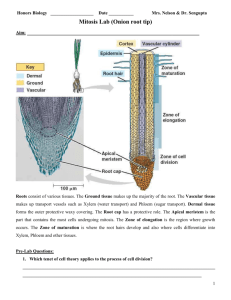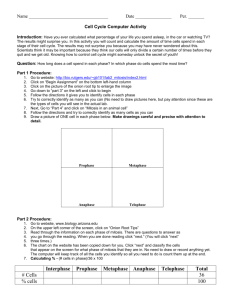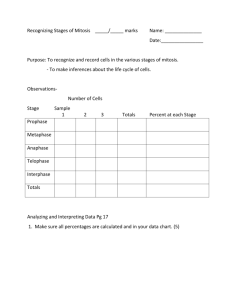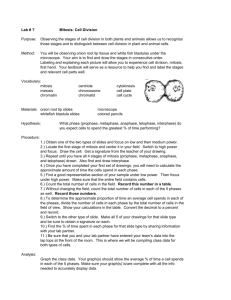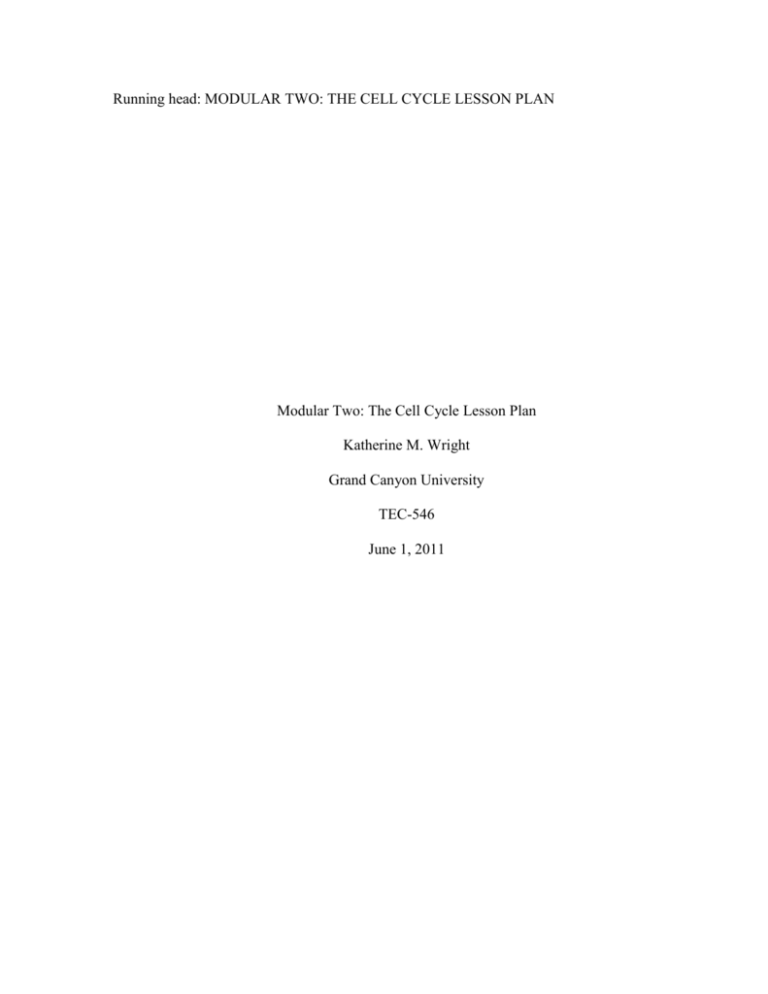
Running head: MODULAR TWO: THE CELL CYCLE LESSON PLAN
Modular Two: The Cell Cycle Lesson Plan
Katherine M. Wright
Grand Canyon University
TEC-546
June 1, 2011
Interactive Lesson Plan:
Classroom Information
Subject Area
Science High School Biology
Grade Level(s)
High School
Analyze Learners
The Students: High school students, grade 9-12+, two four and one half hour sessions (AM—50-75
students, PM—25-50 students, not all students work on science at the same time—they pick
what classes they will work on)
Characteristics of users: Students have not been able to be successful in the typical school setting.
Many are behind in credits, returning to school in their late teens, early 20s, with families and
jobs. Due to their lack of success in the typical school setting, many lack the skills necessary to
be successful, i.e. note taking, reading comprehension. Most of them are more interested in
earning the credit and passing the state test (AIMS) than actually learning the information. Only
two students in the entire school are ELL and very few are SPED, and all are fully immersed.
User tasks: The students will explore the stages of the cell cycle, including interphase, prophase,
prometaphase, metaphase, anaphase, and telophase, learning the major events of each of the
phases and basically what each stage looks like. This information will be applied in a future lab
in which the student will develop a hypothesis about in which of the stages the cells will spend
the most time. The students will then test their hypotheses by identifying the stages of mitosis
found in an onion root tip sample and calculating the percent of cells in each of the stages. They
will then write a mini lab report—introduction, hypothesis, procedure, results, discussion.
Physical environment: Large classroom with 125 individual work stations, each equipped with a
computer.
Social environment: Each student chooses what class they will work on, working individually,
asking for individual help when they need it.
Organizational environment: From four to thirteen teachers roam the room. When a student has a
question, s/he raises her/his hand and a teacher goes over to see what the question is and then
gets the correct teacher to individually help the student. The teacher will work with the student
until the teacher is confident that the student understands the concept. The test-teach-test
principle is used. Typically the students work through a lesson (using the Anywhere Learning
System, ALS, http://www.amered.com/index.php) and take a 10 question practice test, followed
by a 10 question quiz, that must be passed with a 70% before moving on to the next unit. This
task will be an addition to the ALS unit, to enhance the students’ understanding of the cell cycle
(not covered very well by ALS) in preparation for conducting a lab exploring the stages of the
cell cycle.
Student support: All students are very comfortable using the computers, working on their own,
getting help when needed and individual adaptations have been accounted for. (All class work is
done on the computer). There will also be a list of websites where the students can get additional
help. For students that have trouble reading, Read Please (http://www.readplease.com/, a
program that reads the text) is included on all the computers, and students are trained on its use.
Usability aspects: The students will be able to identify the major events in each of the stages of
mitosis—interphase, prophase, metaphase, anaphase, and telophase. They will apply this
knowledge through a short investigation of onion root tip cells and collecting data, write a short
lab report demonstrating their understanding of the cell cycle. All assessments will be at a 70%.
Usability goals: Due to the fact that students are in complete control of the time they spend on each
subject, it is difficult to determine when they will finish the unit. It is hoped that the students will
be able to complete the tutorial on the cell cycle in one to two hours.
Constraints: Students with previous science experience will be able to move through the lessons
faster than the other students. Students that are more interested in just passing the class will be
able to do a minimal amount of work, but will still be getting exposure to important issues found
on the state test. The students are already used to working on their own, at their own pace, and
obtaining help when necessary. This setting works well with the wide range of ages (15-22),
wide range of abilities, and wide range of interest found in the school’s population.
Lesson
Title
The Cell Cycle
Summary
The cell cycle is an important of cellular biology and consists of two divisions—interphase and
mitosis. Each of these divisions is further divided: interphase has 3 divisions and mitosis has 6
divisions. The students will look at the different stages of the cell cycle, learning both the major
events and the important elements involved in the different stages.
Standards
Arizona State -- High School Science
Strand 4: Life Science:
Concept 1: The Cell Understand the role of the cell and cellular processes.
Technology – NETS for Students:
1. Creativity and Innovation
c. use models and simulations to explore complex systems and issues.
6. Technology Operations and Concepts
a. understand and use technology systems.
b. select and use applications effectively and productively.
Learning Objectives (created from learning outcomes)
1. Given the different stages of the cell cycle the student will be able to list them in correct order
with 70% accuracy.
2. Given the different stages of the cell cycle the student will be able to identify the major
characteristics of each of the stages with 70% accuracy.
3. Given a clues/definitions of terms dealing with the cell cycle, the student will be able to
complete a crossword puzzle with 70% accuracy.
Hardware
Computer
Speakers
Software
PowerPoint
Internet
Prerequisite Skills
Use of PowerPoint
Use of the internet.
Duration
This lesson will take 1-2 hours. It is designed for the student to progress at their own rate with
additional websites for additional practice listed. The student will use this information in the next
lesson, which will include a more comprehensive evaluation of their understanding of the
principles.
Grouping
This lesson is designed for the student to work individually, at their own pace.
Procedure
Anticipatory Set: Cells are the basis of all life. An organism, therefore, needs to have a way to
replace cells that are old or damaged as well as to produce new cells enabling the organism to grow.
The method that cells use to do this is called the cell cycle. The cell cycle enables the cells to create
exact duplicates through the process of mitosis. There is also a stage in the cycle for the cell to grow
and produce proteins and other compounds necessary for the cell to maintain its existence.
Teaching Procedures: The student will take a pretest of the information prior to proceeding with the
lesson. After completing the pretest the student will proceed through the PowerPoint going to the
required websites for the additional information and processing. The testing will be done
individually. There are a couple of games the students will participate in to solidify the information
and then they will complete a crossword puzzle using the terms learned in this lesson and retake the
pretest as a post test. In the subsequent lab—onion root tip lab—the student will apply this
knowledge by identifying the different stages of the cell cycle for different cells found in an onion
root tip cross section.
Closure: All cells need a way to create an exact duplicate to enable the organism to grow and to
replace old or worn out cells. The cell cycle provides this function. The cell cycle can be split into
two main parts—interphase, where the cell is growing and getting ready to divide, and mitosis where
the cell is actively undergoing division. It is thought that a cell will spend a large majority of its life
in interphase. If a cell sample were examined and the cells were all labeled according to which of the
phases (G1, S G2, Prophase, prometaphase, metaphase, anaphase, telophase, and cytokinesis) it
would be possible to determine what % of the cell’s life is spent in each of the different phases. We
will be doing an experiment to determine exactly this.
Assessment (Summative and Formative)
1. Given the different stages of the cell cycle the student will be able to list them in correct order
with 70% accuracy. Assessment: Label the stages game -http://www.purposegames.com/game/cell-mitosis-quiz/info
2. Given the different stages of the cell cycle the student will be able to identify the major
characteristics of each of the stages with 70% accuracy. Assessment: Online quiz: CRA
Biology classes -- The Cell Cycle, from QuizStar. http://quizstar.4teachers.org/
3. Given a clues/definitions of terms dealing with the cell cycle, the student will be able to
complete a crossword puzzle with 70% accuracy. Assessment: Cells Alive Mitosis
Crossword Puzzle -- http://www.cellsalive.com/puzzles/mitosis/index.html
Extension Items
Students can explore the internet for additional games and/or you tube explanations.
Areas of Concern
Because the class is self paced some students will not spend the time and effort necessary to
completely understand the principles. If this occurs they will find that when it is time to do the lab
they will need to review the information. Because the information is self-contained in the tutorial, this
will be possible and the students will be able to review the information as often as necessary.
© 2010. Grand Canyon University. All Rights Reserved.



